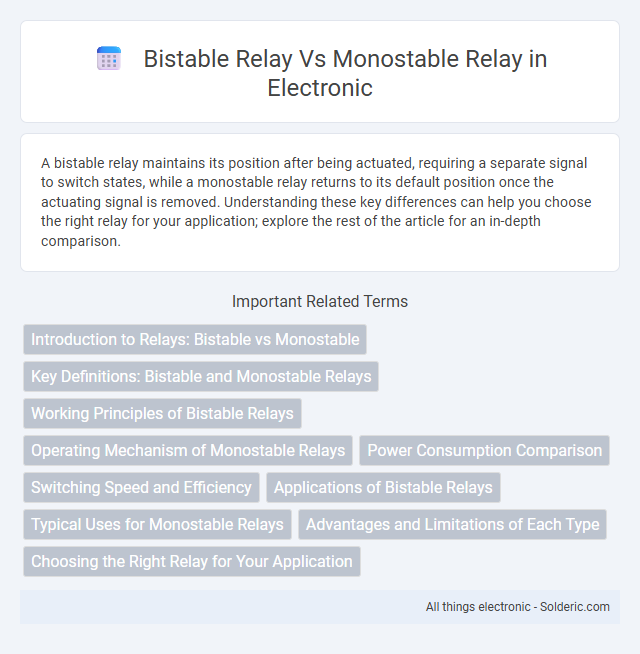A bistable relay maintains its position after being actuated, requiring a separate signal to switch states, while a monostable relay returns to its default position once the actuating signal is removed. Understanding these key differences can help you choose the right relay for your application; explore the rest of the article for an in-depth comparison.
Comparison Table
| Feature | Bistable Relay | Monostable Relay |
|---|---|---|
| Definition | Two stable states; maintains position without power. | One stable state; returns to default when power is removed. |
| Power Consumption | Consumes power only during switching. | Consumes power continuously to remain activated. |
| Switching Mechanism | Latch coil toggles between two states. | Electromagnetic coil activates and returns. |
| Applications | Memory circuits, power-saving switches. | Timing circuits, temporary activation scenarios. |
| State Retention | Maintains state without power. | State reverts on power loss. |
Introduction to Relays: Bistable vs Monostable
Bistable relays maintain their position after activation, requiring a separate signal to switch states, which optimizes energy consumption and provides stable switching in memory-based applications. Monostable relays return to their default position once the activation signal is removed, making them ideal for applications requiring temporary switching, such as pulse generation or timing circuits. The choice between bistable and monostable relays depends on factors like power efficiency, holding capability, and specific operational requirements in control systems.
Key Definitions: Bistable and Monostable Relays
Bistable relays maintain their position after being actuated, requiring an external signal to switch states, which conserves energy by holding the last state without continuous power. Monostable relays return to their default position when the actuating signal is removed, using continuous power only during activation. Understanding these key definitions helps you select the appropriate relay type for applications needing either stable memory or temporary switching.
Working Principles of Bistable Relays
Bistable relays operate by maintaining their position without continuous power, using magnetic latching to switch between two stable states. Their coils receive short pulses to toggle the relay on or off, significantly reducing energy consumption compared to monostable relays. This efficient working principle allows your control systems to hold a specific state reliably without constant electrical input.
Operating Mechanism of Monostable Relays
Monostable relays operate using an electromagnetic coil that, when energized, moves the contact from its resting position to an active state and returns to the default position once the power is removed. This mechanism relies on a spring or magnetic force to reset the relay, ensuring that the contacts are only temporarily switched. Your control system benefits from this design when a temporary or momentary switching action is required.
Power Consumption Comparison
Bistable relays consume power only during state changes, resulting in significantly lower energy usage compared to monostable relays, which require continuous power to maintain their position. This makes bistable relays ideal for battery-powered or energy-sensitive applications, as their hold states are maintained without ongoing electricity. Monostable relays, on the other hand, constantly draw current to stay activated, leading to higher overall power consumption.
Switching Speed and Efficiency
Bistable relays offer faster switching speeds by maintaining their state without continuous power, enhancing overall efficiency in power consumption compared to monostable relays, which require constant power to hold their position. Your choice impacts energy efficiency and response time, as bistable relays reduce heat generation and energy loss during operation. Monostable relays typically have slower switching speeds due to the need for continuous coil activation, which can increase power usage and reduce operational lifespan.
Applications of Bistable Relays
Bistable relays are widely used in applications requiring memory retention without continuous power, such as in lighting control systems, industrial automation, and smart home devices. Their ability to maintain position after actuation makes them ideal for energy-saving switches and wireless remote control systems. These relays are also critical in safety circuits and position indicators where stable state retention is necessary.
Typical Uses for Monostable Relays
Monostable relays are commonly used in applications requiring a temporary switch or pulse, such as timer circuits, doorbells, and motor starters. Their design allows the relay to return to its default state once the activating signal is removed, ensuring controlled, short-duration operation. Your projects benefit from monostable relays when precise, momentary actuation is essential for safety or functionality.
Advantages and Limitations of Each Type
Bistable relays maintain their position without continuous power, offering energy efficiency and stability in applications requiring state retention, but they can be more complex and costly. Monostable relays return to a default position when power is removed, providing simplicity and faster response times, yet they consume power continuously during activation and lack memory capability. Understanding these advantages and limitations helps you choose the appropriate relay type for specific electrical control needs.
Choosing the Right Relay for Your Application
Choosing the right relay for your application depends on the required switching behavior and power consumption. Bistable relays maintain their position without continuous power, making them ideal for energy-efficient and memory-retentive uses. Monostable relays return to a default state when power is removed, providing reliable fail-safe operation in time-sensitive circuits.
bistable relay vs monostable relay Infographic

 solderic.com
solderic.com